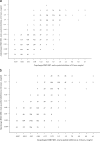Correlation of MIC with outcome for Candida species tested against caspofungin, anidulafungin, and micafungin: analysis and proposal for interpretive MIC breakpoints
- PMID: 18579718
- PMCID: PMC2519503
- DOI: 10.1128/JCM.00566-08
Correlation of MIC with outcome for Candida species tested against caspofungin, anidulafungin, and micafungin: analysis and proposal for interpretive MIC breakpoints
Abstract
The CLSI Antifungal Subcommittee followed the M23-A2 "blueprint" to develop interpretive MIC breakpoints for anidulafungin, caspofungin, and micafungin against Candida species. MICs of < or = 2 microg/ml for all three echinocandins encompass 98.8 to 100% of all clinical isolates of Candida spp. without bisecting any species group and represent a concentration that is easily maintained throughout the dosing period. Data from phase III clinical trials demonstrate that the standard dosing regimens for each of these agents may be used to treat infections due to Candida spp. for which MICs are as high as 2 microg/ml. An MIC predictive of resistance to these agents cannot be defined based on the data from clinical trials due to the paucity of isolates for which MICs exceed 2 microg/ml. The clinical data set included only three isolates from patients treated with an echinocandin (caspofungin) for which the MICs were > 2 microg/ml (two C. parapsilosis isolates at 4 microg/ml and one C. rugosa isolate at 8 microg/ml). Based on these data, the CLSI subcommittee has decided to recommend a "susceptible only" breakpoint MIC of < or = 2 microg/ml due to the lack of echinocandin resistance in the population of Candida isolates thus far. Isolates for which MICs exceed 2 microg/ml should be designated "nonsusceptible" (NS). For strains yielding results suggestive of an NS category, the organism identification and antimicrobial-susceptibility test results should be confirmed. Subsequently, the isolates should be submitted to a reference laboratory that will confirm the results by using a CLSI reference dilution method.
Figures


Similar articles
-
In vitro susceptibility of invasive isolates of Candida spp. to anidulafungin, caspofungin, and micafungin: six years of global surveillance.J Clin Microbiol. 2008 Jan;46(1):150-6. doi: 10.1128/JCM.01901-07. Epub 2007 Nov 21. J Clin Microbiol. 2008. PMID: 18032613 Free PMC article.
-
Anidulafungin and micafungin MIC breakpoints are superior to that of caspofungin for identifying FKS mutant Candida glabrata strains and Echinocandin resistance.Antimicrob Agents Chemother. 2013 Dec;57(12):6361-5. doi: 10.1128/AAC.01451-13. Epub 2013 Sep 23. Antimicrob Agents Chemother. 2013. PMID: 24060873 Free PMC article.
-
Susceptibility to echinocandins of Candida spp. strains isolated in Italy assessed by European Committee for Antimicrobial Susceptibility Testing and Clinical Laboratory Standards Institute broth microdilution methods.BMC Microbiol. 2015 May 20;15:106. doi: 10.1186/s12866-015-0442-4. BMC Microbiol. 2015. PMID: 25990252 Free PMC article.
-
Candida and candidaemia. Susceptibility and epidemiology.Dan Med J. 2013 Nov;60(11):B4698. Dan Med J. 2013. PMID: 24192246 Review.
-
Clinical breakpoints for the echinocandins and Candida revisited: integration of molecular, clinical, and microbiological data to arrive at species-specific interpretive criteria.Drug Resist Updat. 2011 Jun;14(3):164-76. doi: 10.1016/j.drup.2011.01.004. Epub 2011 Feb 24. Drug Resist Updat. 2011. PMID: 21353623 Review.
Cited by
-
Update on the Pathogenesis, Virulence, and Treatment of Candida auris.Pathog Immun. 2022 Oct 21;7(2):46-65. doi: 10.20411/pai.v7i2.535. eCollection 2022. Pathog Immun. 2022. PMID: 36329818 Free PMC article. Review.
-
Brazilian guidelines for the management of candidiasis - a joint meeting report of three medical societies: Sociedade Brasileira de Infectologia, Sociedade Paulista de Infectologia and Sociedade Brasileira de Medicina Tropical.Braz J Infect Dis. 2013 May-Jun;17(3):283-312. doi: 10.1016/j.bjid.2013.02.001. Epub 2013 May 18. Braz J Infect Dis. 2013. PMID: 23693017 Free PMC article.
-
Fixed-ratio combination testing of an echinocandin, anidulafungin, and an azole, voriconazole, against 1,467 Candida species isolates.Antimicrob Agents Chemother. 2010 Sep;54(9):4041-3. doi: 10.1128/AAC.00330-10. Epub 2010 Jun 14. Antimicrob Agents Chemother. 2010. PMID: 20547802 Free PMC article. No abstract available.
-
Acquisition of flucytosine, azole, and caspofungin resistance in Candida glabrata bloodstream isolates serially obtained from a hematopoietic stem cell transplant recipient.Antimicrob Agents Chemother. 2010 Mar;54(3):1360-2. doi: 10.1128/AAC.01138-09. Epub 2009 Dec 28. Antimicrob Agents Chemother. 2010. PMID: 20038613 Free PMC article.
-
Anidulafungin, a new echinocandin: in vitro activity.Drugs. 2009;69 Suppl 1:91-4. doi: 10.2165/11315560-000000000-00000. Drugs. 2009. PMID: 19877740 Review.
References
Publication types
MeSH terms
Substances
LinkOut - more resources
Full Text Sources
Other Literature Sources
Medical
Miscellaneous

